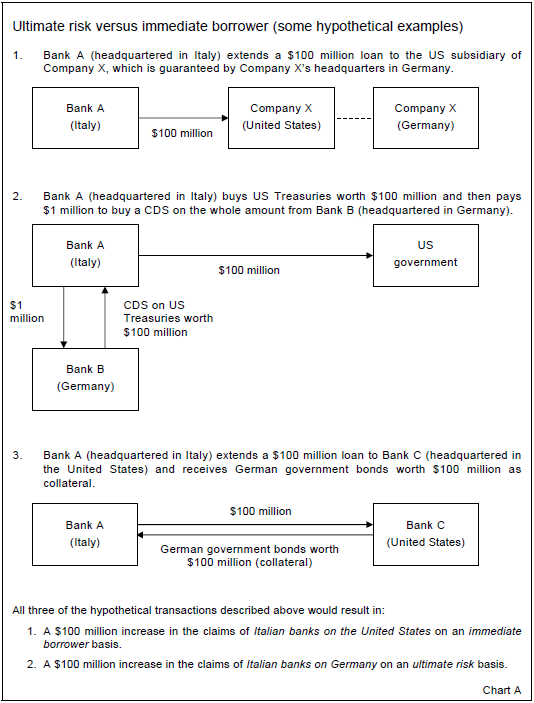What the BIS banking statistics say (and what they do not) about banking systems' exposures to particular countries and sectors
(Extract from pages 16-17 of BIS Quarterly Review, March 2011)
The BIS consolidated international banking statistics provide a unique perspective on the exposures of national banking systems to particular countries and sectors. The statistics provide information on the total foreign exposures (ie foreign claims plus other exposures) of banks headquartered in a particular jurisdiction on a worldwide consolidated basis (ie including the exposures of consolidated foreign branches and subsidiaries and netting out inter-office positions). The BIS consolidated banking statistics offer a more useful measure of the total risk exposure of a banking system than do the BIS locational banking statistics, which are based on the residence (rather than on the nationality of ownership) of the reporting banking unit.
The BIS consolidated banking statistics are reported on both an ultimate risk and an immediate borrower basis. In the former case, the statistics are adjusted for net risk transfers between countries and sectors, while in the latter they are not. Chart A shows three examples of risk transfers that would generate differences between figures reported, respectively, on an ultimate risk and on an immediate borrower basis.
Several important caveats should be kept in mind when analysing figures obtained from the BIS consolidated banking statistics. The first is that the statistics capture the foreign exposures of reporting banking systems to given countries, not the expected losses that those banking systems would suffer as a result of a large negative shock to their assets in those countries. For example, if the foreign exposures of banks headquartered in country X to country Y amounted to $60 billion and an event inflicted losses of 25% on all foreign-owned assets in country Y, banks from country X would sustain losses of $15 billion (not $60 billion). Furthermore, the BIS consolidated banking statistics focus exclusively on assets and provide no information on liabilities to the same debtor.
Second, in the BIS consolidated banking statistics, the holdings of various banking units are assigned to a given national jurisdiction according to the nationality of the highest-level banking affiliate in the chain of ownership, not according to the nationality of the ultimate parent. For example, the claims of a bank that is incorporated in country X and is owned by a non-bank financial company headquartered in country Y would be reported as a part of the claims of the banking sector of X (and not of Y). As a result, the set of banks that report to the BIS consolidated banking statistics as a part of the banking population of country X and the set of banks that are regulated and/or guaranteed by the government of country X do not necessarily overlap.
Third, the BIS consolidated banking statistics do not include a currency breakdown. Furthermore, no information is available on which claims are marked to market and which are held to maturity. As a result, it is difficult to interpret changes in the stocks of foreign claims because it is impossible to know exactly how much of a given change was caused by currency fluctuations, how much of it occurred as a result of adjustments in the mark to market values of claims and how much was due to banks actively changing the quantities of these claims that they own (ie buying and selling claims). The most that can be done in that dimension is to obtain estimates of exchange rate-adjusted changes in foreign claims based on assumptions about their currency composition.
While the BIS consolidated banking statistics are very useful in answering certain questions, they cannot be used to address all issues related to a given topic. For example, the BIS consolidated banking statistics can be used to answer a question such as:
What are the exposures of banks headquartered in country X to country Y?
However, they cannot be used to answer a question such as:
How much would banks headquartered in country X lose in the event of a sovereign restructuring in country Y?
Similarly, the BIS consolidated banking statistics can be used to answer a question such as:
What are the overall foreign exposures of banks headquartered in country X?
However, they cannot be used to answer a question such as:
What are the overall foreign exposures of banks that have an explicit (or an implicit) guarantee by the government of country X?
The BIS consolidated banking statistics can also be used to answer a question such as:
What were the foreign claims of banks headquartered in country X on country Y at a given point in time?
However, they cannot be used to answer a question such as:
How much of the change in foreign claims of banks headquartered in country X on country Y during a given period was due to banks actively changing the quantities of these claims that they own and how much was caused by fluctuations in the market values of the claims?

